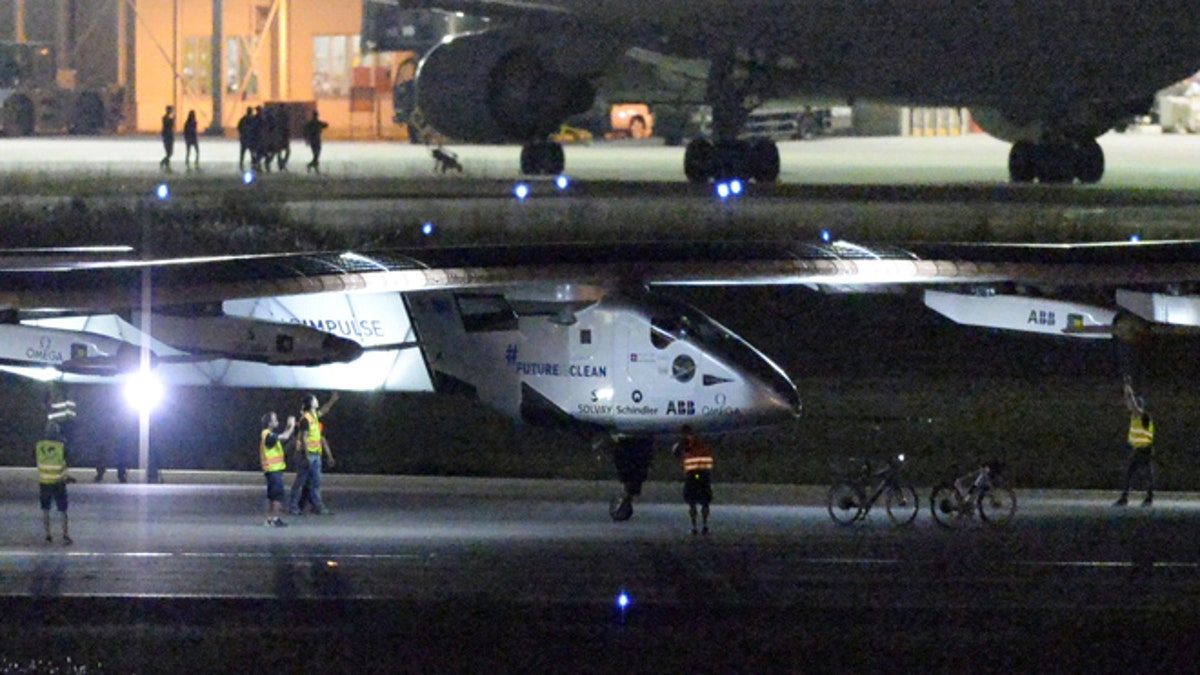
June 1, 2015: The Solar Impulse 2 project staff members gather around the aircraft as it lands the Nagoya Airport in Toyoyama, near Nagoya, central Japan. (Takuya Inaba/Kyodo News via AP)
NAGOYA, Japan – A solar-powered plane carrying no fuel has postponed its departure from central Japan for Hawaii due to worse than expected weather conditions.
Swiss pilot and project co-founder said the weather window for the flight early Wednesday had disappeared. After analyzing conditions, the decision was made to take the plane back to its mobile hangar.
"The latest weather run shows the corridor we want to take has closed," said Bertrand Piccard, who is taking turns flying the plane with his co-pilot Andre Borschberg.
Borschberg, who is to fly the Japan-Hawaii leg of the round-the-world journey, was seen sitting in the plane's cockpit, looking patient but serious.
A live video feed showed the staff in the control center in Monaco engaged in intense discussions. The plane needed to take off before sunrise because it would become too hot and windy to either leave or return it to the inflatable mobile hangar at Nagoya's Komaki airport.
"We are really in the worst moment when we don't know what to say," Piccard said earlier in an interview from Monaco.
Borschberg landed on June 1 while en route from the Chinese city of Nanjing to Honolulu. He was to fly the plane solo during the roughly five-day trip, taking short naps, doing yoga and meditating to endure the lack of sleep.
The airplane carries no fuel, so project engineers are using simulations to determine when it is safe to fly. The first Pacific leg is the riskiest because there is no place to land.
Borschberg has been waiting for a weather front stretching from Alaska to Taiwan to clear enough for him to resume the 8,175 kilometer (5,079-mile) journey across the western Pacific, the longest leg of the round-the-world journey which began in Abu Dhabi.
The length of the journey means that the weather forecasts the project's simulators use to decide if it is safe to embark are at their limits of reliability, he said.
"We don't want to take too much of a risk," Borschberg told reporters earlier in Tokyo. "Either the airplane is still flying and it gets to where it is going, or it's in the water and it's a failure. It's either 100 percent or 0 percent. There is no 50 percent. That is why we are so careful."
"I will really believe in this window to Hawaii when I will have crossed the point of no-return!" he tweeted on Tuesday.
On the ground in Nagoya, the plane was slightly damaged when a cover was tousled by the wind, but it has been repaired and ready to go for days.
Piccard, the project's leader, will be guiding Borschberg from the control center in Monaco. They are taking turns flying the plane solo.
The Solar Impulse 2 is powered by more than 17,000 solar cells on its wings that recharge its batteries, enabling it to fly. But bad weather and nights are challenges because diverting around clouds takes extra energy, and the aircraft is not designed to withstand rain, turbulence and heavy winds.
The aircraft travels at about the same speeds as a vehicle. At night, it descends from its maximum altitude of 8,500 meters (27,900 feet) to 3,000 meters (9,850 feet) to minimize power consumption as it draws from its batteries.
In the morning, the plane resumes producing power, but it needs to have enough left-over power to ascend to the daytime altitude.
The Solar Impulse project is meant to demonstrate the potential of improved energy efficiency and clean power, though solar-powered air travel is not yet commercially practical, given the slow travel time, weather and weight constraints of the aircraft.
